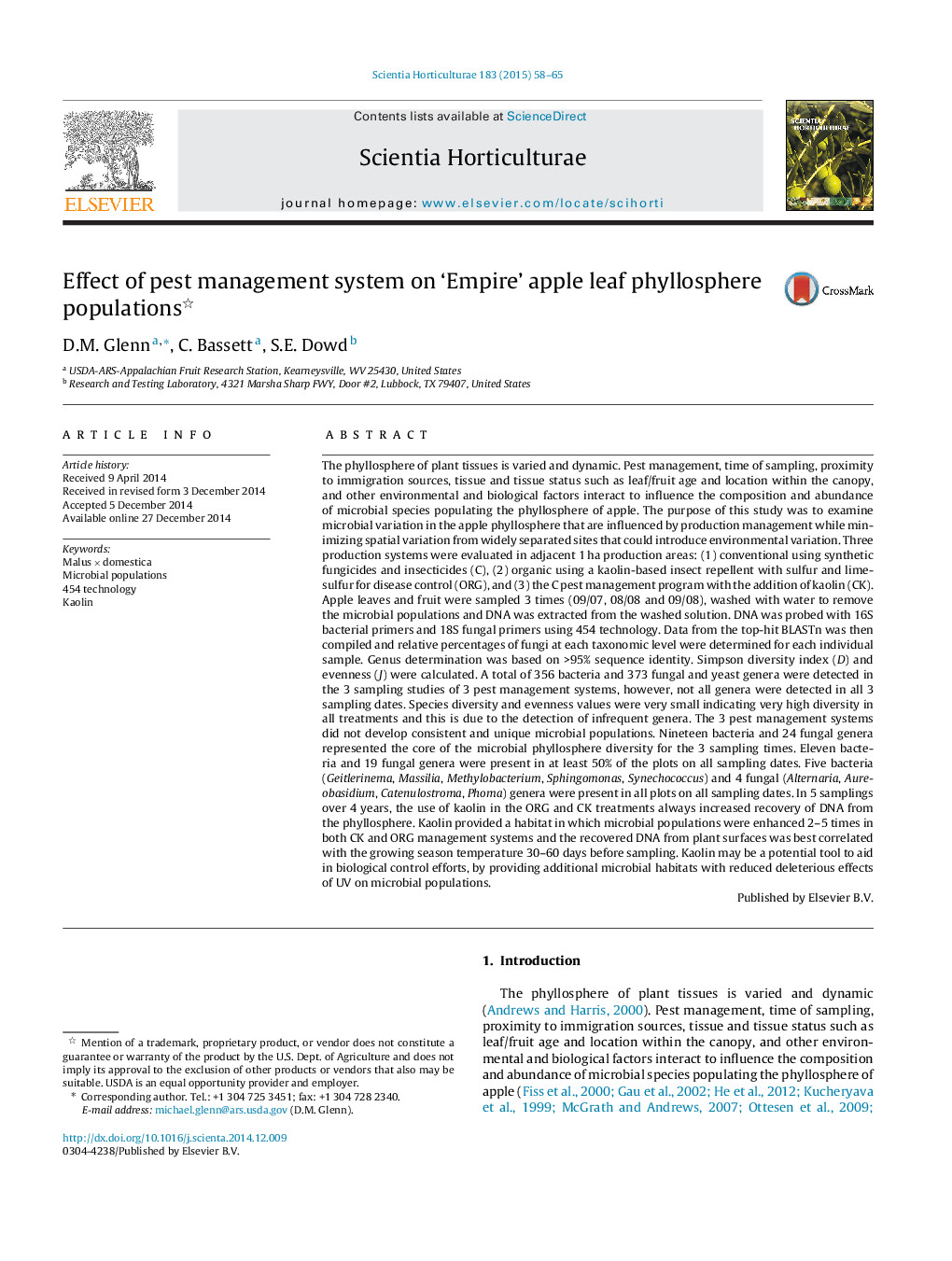| کد مقاله | کد نشریه | سال انتشار | مقاله انگلیسی | نسخه تمام متن |
|---|---|---|---|---|
| 6407120 | 1628815 | 2015 | 8 صفحه PDF | دانلود رایگان |

- Conventional (C), organic-kaolin (ORG) and C-kaolin (CK) apple systems were evaluated.
- Microbial DNA was extracted from apple leaves and fruit 3 times.
- The 3 pest management systems did not develop consistent microbial populations.
- 19 bacteria and 24 fungal genera represented the core populations for the 3 samplings.
- Kaolin provided a habitat in which microbial populations were enhanced 2-5 times.
The phyllosphere of plant tissues is varied and dynamic. Pest management, time of sampling, proximity to immigration sources, tissue and tissue status such as leaf/fruit age and location within the canopy, and other environmental and biological factors interact to influence the composition and abundance of microbial species populating the phyllosphere of apple. The purpose of this study was to examine microbial variation in the apple phyllosphere that are influenced by production management while minimizing spatial variation from widely separated sites that could introduce environmental variation. Three production systems were evaluated in adjacent 1Â ha production areas: (1) conventional using synthetic fungicides and insecticides (C), (2) organic using a kaolin-based insect repellent with sulfur and lime-sulfur for disease control (ORG), and (3) the C pest management program with the addition of kaolin (CK). Apple leaves and fruit were sampled 3 times (09/07, 08/08 and 09/08), washed with water to remove the microbial populations and DNA was extracted from the washed solution. DNA was probed with 16S bacterial primers and 18S fungal primers using 454 technology. Data from the top-hit BLASTn was then compiled and relative percentages of fungi at each taxonomic level were determined for each individual sample. Genus determination was based on >95% sequence identity. Simpson diversity index (D) and evenness (J) were calculated. A total of 356 bacteria and 373 fungal and yeast genera were detected in the 3 sampling studies of 3 pest management systems, however, not all genera were detected in all 3 sampling dates. Species diversity and evenness values were very small indicating very high diversity in all treatments and this is due to the detection of infrequent genera. The 3 pest management systems did not develop consistent and unique microbial populations. Nineteen bacteria and 24 fungal genera represented the core of the microbial phyllosphere diversity for the 3 sampling times. Eleven bacteria and 19 fungal genera were present in at least 50% of the plots on all sampling dates. Five bacteria (Geitlerinema, Massilia, Methylobacterium, Sphingomonas, Synechococcus) and 4 fungal (Alternaria, Aureobasidium, Catenulostroma, Phoma) genera were present in all plots on all sampling dates. In 5 samplings over 4 years, the use of kaolin in the ORG and CK treatments always increased recovery of DNA from the phyllosphere. Kaolin provided a habitat in which microbial populations were enhanced 2-5 times in both CK and ORG management systems and the recovered DNA from plant surfaces was best correlated with the growing season temperature 30-60 days before sampling. Kaolin may be a potential tool to aid in biological control efforts, by providing additional microbial habitats with reduced deleterious effects of UV on microbial populations.
Journal: Scientia Horticulturae - Volume 183, 12 February 2015, Pages 58-65